Braiding is far more than a simple hairstyle—it’s an ancient art form with deep cultural significance that spans continents and millennia. From the intricate cornrows of West Africa to the ceremonial plaits of Native American tribes, braided hairstyles have served as powerful symbols of identity, social status, spirituality, and resistance throughout human history. Join us as we unravel the fascinating cultural history of braiding and discover how these woven strands connect us across time and place.
The Ancient Origins of Braiding
The practice of braiding hair dates back thousands of years, with evidence appearing across multiple ancient civilizations. Archaeological findings and historical records reveal that braiding emerged independently in various parts of the world, each culture developing unique techniques and meanings.
Ancient Egyptian wall painting depicting figures with braided hairstyles, circa 3000 BCE
Africa: The Cradle of Braiding
Africa is widely recognized as the birthplace of braiding, with evidence dating back at least 5,000 years. The oldest known depictions of braids come from the Nile Valley civilizations, particularly ancient Egypt. The Venus of Willendorf and the Venus of Brassempouy, ancient figurines dating back 25,000-30,000 years, show clear evidence of braided hairstyles, suggesting the practice may be even older than written records indicate.
In many African societies, braiding was not merely aesthetic but served as a complex social language. Different patterns, styles, and techniques communicated important information about a person’s:
- Tribal affiliation and ethnic identity
- Age and stage of life (childhood, puberty, adulthood, marriage)
- Social status and wealth
- Religious beliefs and spiritual practices
- Marital status and family lineage
The Himba people of Namibia, for example, developed elaborate braiding techniques using ochre clay, butter fat, and herbs to create distinctive red locs. These styles not only protected their hair from the harsh desert climate but also indicated a woman’s age and social status within the community.
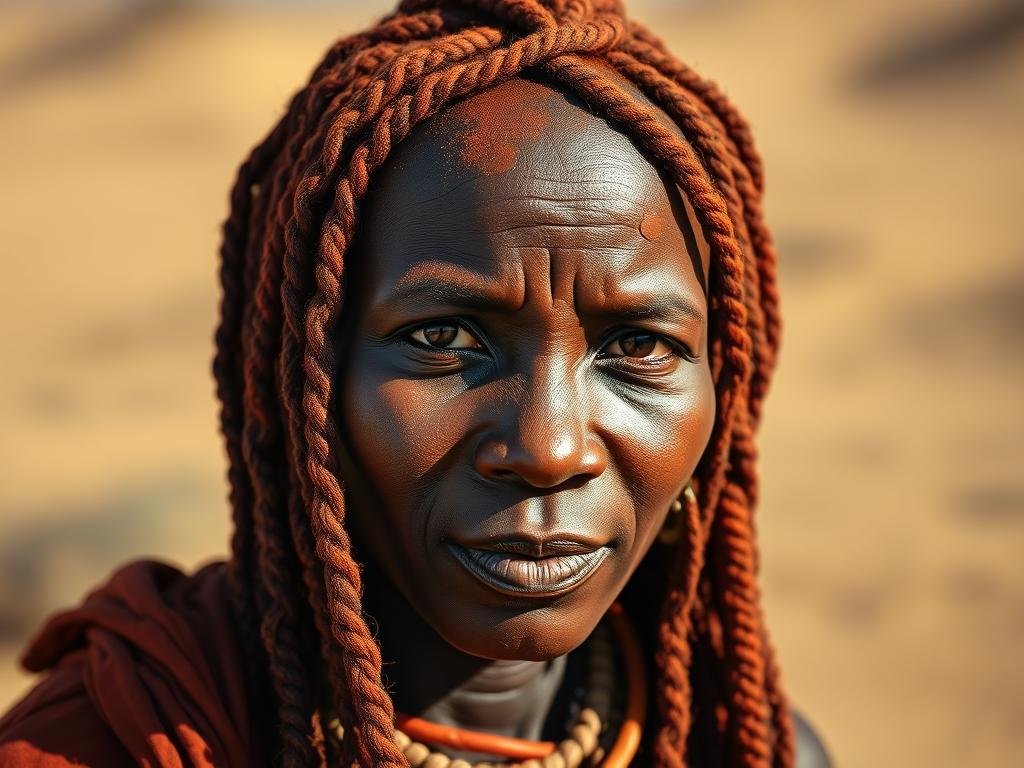
Himba woman from Namibia with traditional red clay braids that signify age and social status
Iconic Braiding Styles and Their Cultural Significance
Throughout history, different cultures have developed distinctive braiding styles that reflect their unique identities, values, and environments. These styles have evolved over generations, adapting to changing social conditions while maintaining their cultural significance.
Cornrows: Ancient Roots and Modern Expressions
Cornrows—braids created close to the scalp in straight, raised rows—have a history dating back at least 3,000 years. Archaeological evidence from the Horn of Africa and West African coastal regions shows that cornrows were widely practiced among diverse ethnic groups.
What makes cornrows distinctive is their technique: an underhand motion followed by an upward one, creating the characteristic raised pattern. In many African societies, cornrow patterns were intricate maps that could contain hidden messages or represent specific tribal affiliations.
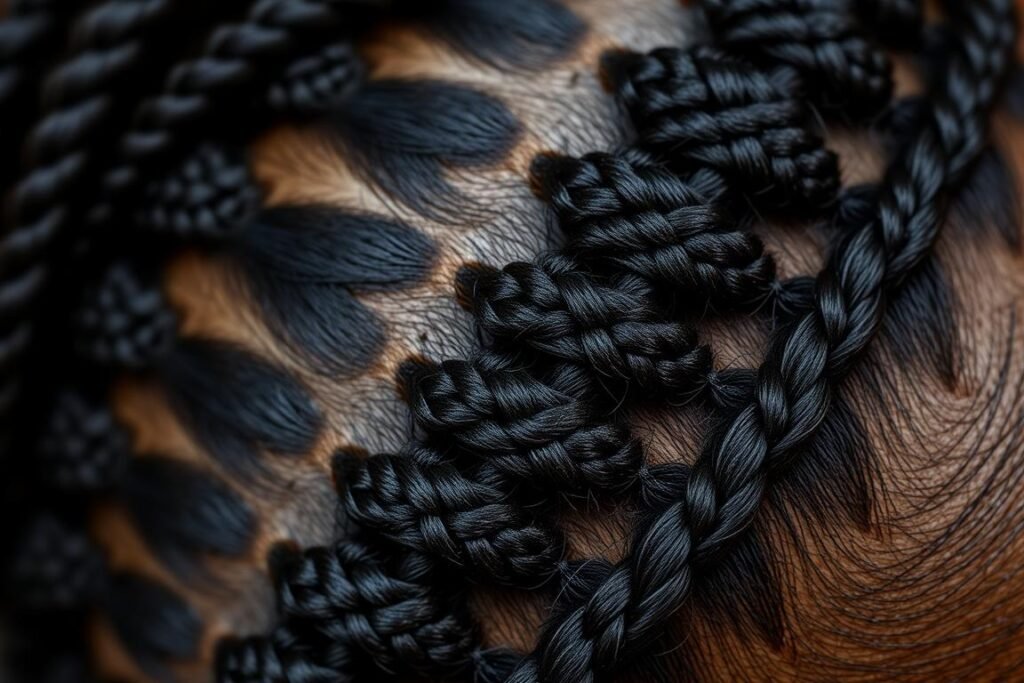
Intricate cornrow pattern demonstrating the geometric precision of traditional African braiding techniques
Fulani Braids: Nomadic Heritage
Fulani braids, named after the Fula people of the Sahel and West African regions, feature a distinctive style with a single cornrow braided down the center of the head, additional braids toward the face, and often a braid around the hairline. Long braids hang on the sides of the head, typically adorned with beads, shells, or jewelry.
For the nomadic Fulani people, these braids were not only beautiful but practical, keeping hair neat during travel and signifying cultural identity. The specific patterns and adornments often indicated a woman’s marital status, age, and wealth.
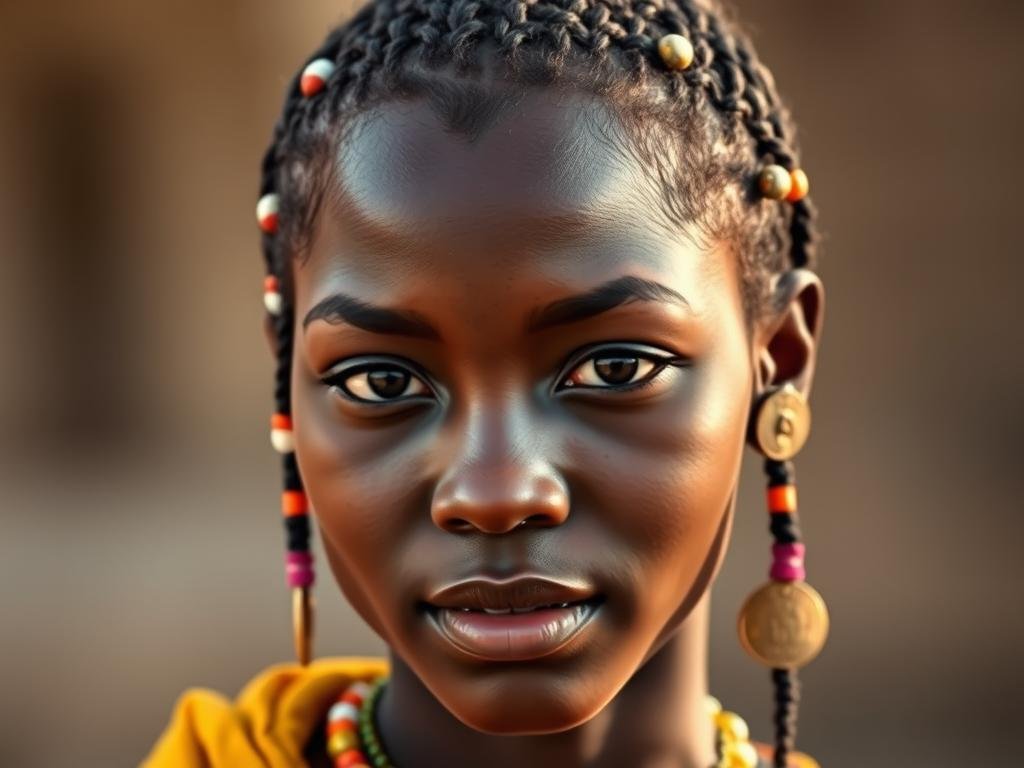
Traditional Fulani braids adorned with beads and coins, reflecting cultural identity and status
Box Braids: Protection and Expression
Box braids, characterized by square-shaped hair divisions on the scalp, originated in various regions of Africa, particularly among peoples of the Eastern African Nile Valley and southeastern regions like Namibia and South Africa. Unlike cornrows, box braids hang freely from the head, allowing for versatile styling options.
These braids served both practical and cultural purposes—protecting the hair from harsh environmental conditions while expressing cultural identity. The size, length, and pattern of box braids often varied according to regional customs and personal preference.
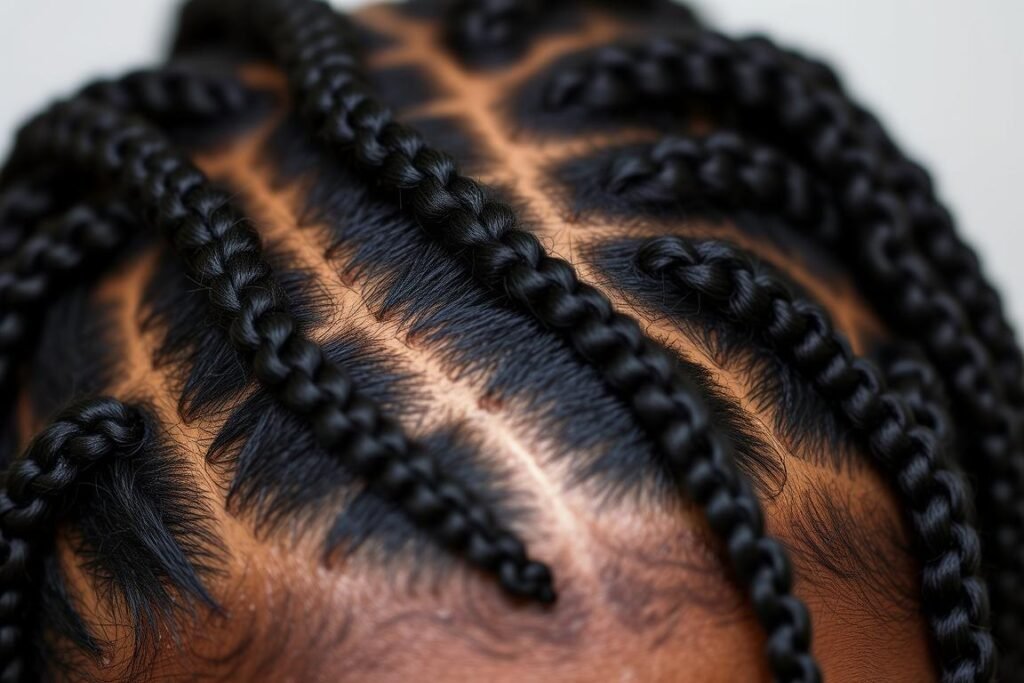
Close-up of box braids showing the distinctive square-shaped partings that give them their name
Braiding Traditions Across Continents
While Africa is often recognized as the birthplace of braiding, cultures around the world developed their own unique braiding traditions, each reflecting local values, materials, and social structures.
Native American Braiding Traditions
Among Indigenous peoples of the Americas, braiding held profound cultural and spiritual significance. Many tribes used braided hairstyles to communicate tribal affiliation, family lineage, and individual achievements. The specific techniques, patterns, and adornments varied widely among different nations.
For many Plains tribes, men wore their hair in two long braids, sometimes wrapped in fur or cloth. These braids could signify warrior status, with specific styles or decorations indicating battle achievements. Women’s braiding styles often reflected marital status and tribal identity.

Traditional Native American braided hairstyle with decorative wrappings that signify cultural identity
Beyond aesthetic considerations, braiding in Native American cultures was often a communal activity that strengthened social bonds. Elders would pass down braiding techniques to younger generations, along with stories, traditions, and cultural knowledge.
Asian Braiding Practices
Across Asia, diverse braiding traditions emerged that reflected local cultural values and social hierarchies. In China during the Han dynasty (206 BCE-220 CE), elaborate braided hairstyles indicated social status, with nobility wearing more complex styles than commoners.
The traditional Chinese braid known as the queue—a single long braid worn by men—became mandatory during the Qing dynasty (1644-1912) as a symbol of submission to Manchu rule. Refusal to wear this style could be punishable by death, demonstrating how braided hairstyles could be powerful political symbols.
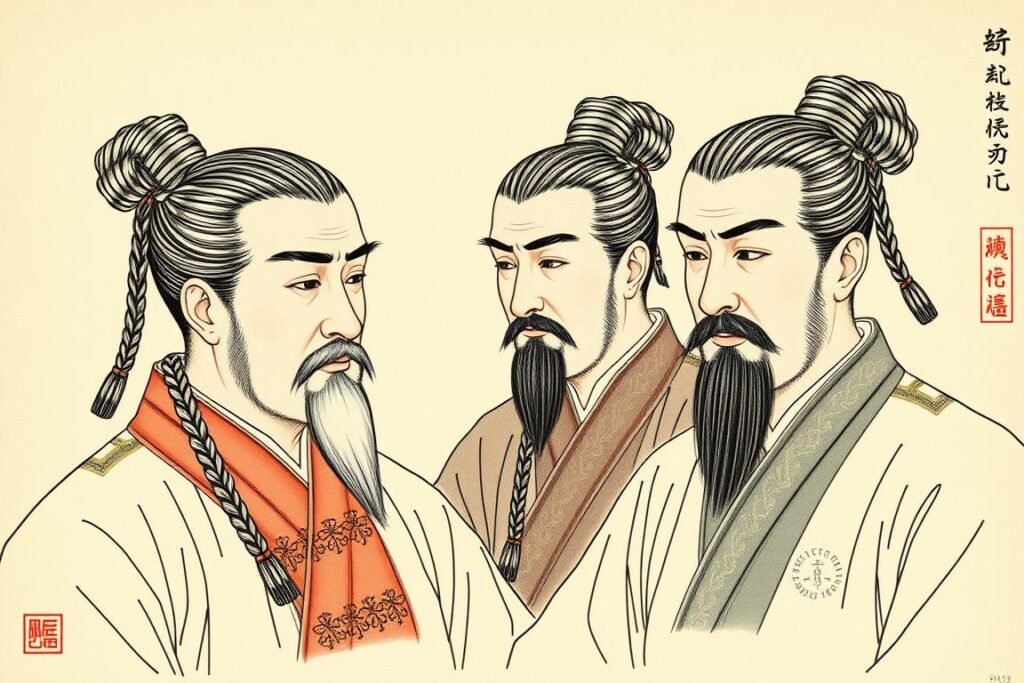
Historical illustration depicting Chinese queue braids from the Qing dynasty, a politically mandated hairstyle
In Japan, geisha and maiko (apprentice geisha) wore elaborate braided hairstyles that indicated their rank and experience. These styles, such as the shimada and the ofuku, required skilled artisans to create and maintain, often using hair extensions, wax, and decorative ornaments.
European Braiding Evolution
European braiding traditions evolved from practical styles worn by peasants to elaborate fashions adopted by nobility. During the Medieval and Renaissance periods, women often wore their hair in braided coronets or coils at the sides of the head, sometimes covered with veils or headdresses.
Viking cultures in Scandinavia developed distinctive braiding styles for both men and women. Archaeological evidence suggests that Viking men sometimes wore elaborate braids and knots, possibly indicating status or family affiliation. Women’s braids were often worn long, sometimes under decorative head coverings.
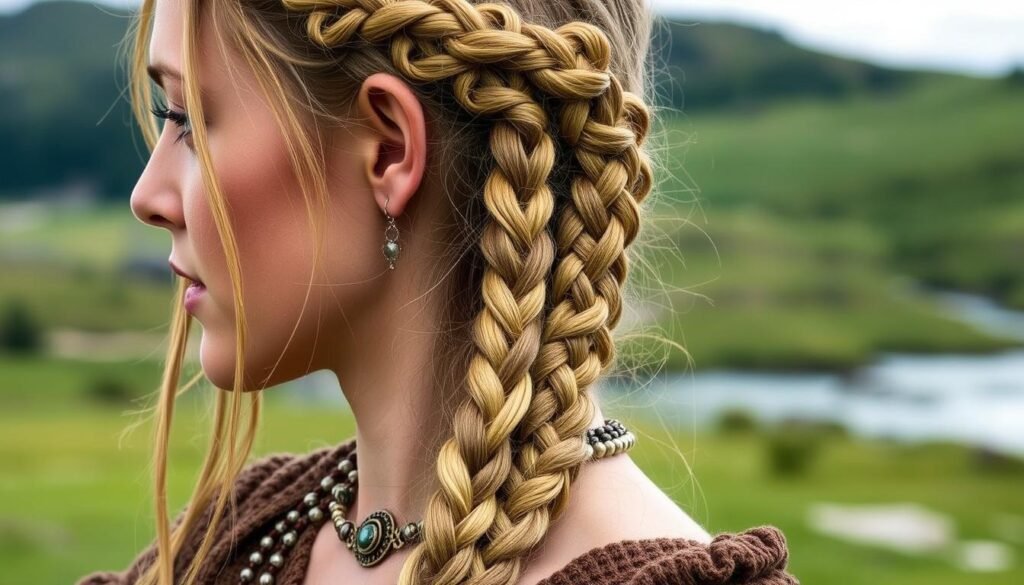
Recreation of Viking-era braided hairstyles, showing the cultural significance of hair in Norse society
Modern Reinterpretations and Cultural Exchange
The 20th and 21st centuries have seen braiding traditions evolve in response to globalization, political movements, fashion trends, and cultural exchange. While maintaining connections to their historical roots, contemporary braiding styles often reflect new social realities and personal expressions.
Braids as Political Statements
During the Civil Rights and Black Power movements of the 1960s and 1970s, natural hairstyles including braids became powerful symbols of resistance against Eurocentric beauty standards and racial oppression. The “Black is Beautiful” movement encouraged African Americans to embrace their natural hair textures and traditional styling techniques as expressions of cultural pride and political consciousness.
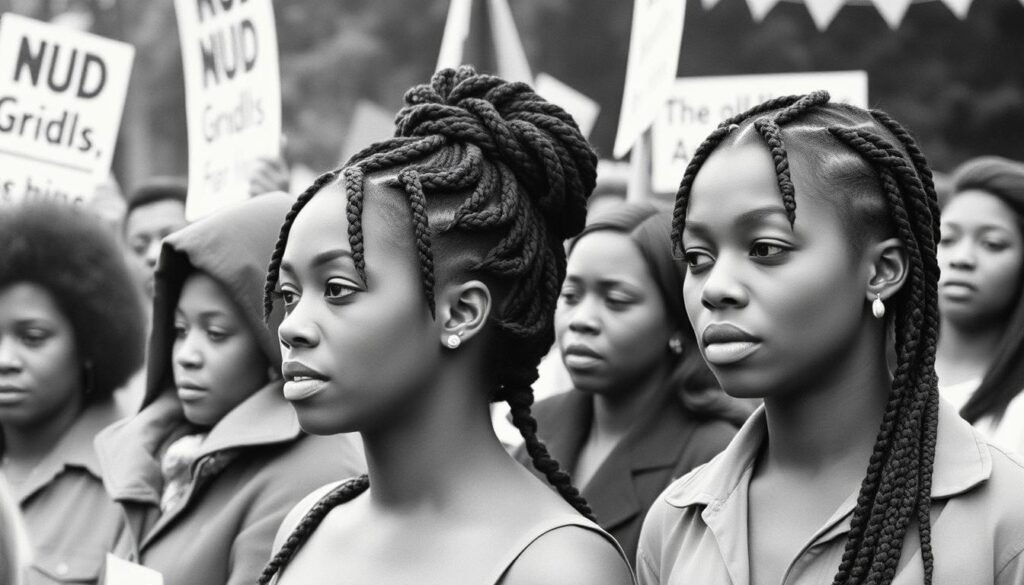
1970s photograph showing braided hairstyles as expressions of cultural pride during the Black Power movement
This political dimension of braiding continues today, with many people choosing traditional braiding styles as assertions of cultural identity and resistance against assimilation pressures. Legal battles against discrimination based on natural hairstyles have highlighted the ongoing significance of braids as expressions of cultural heritage.
Celebrity Influence and Pop Culture
Celebrities and public figures have played significant roles in popularizing various braiding styles across cultural boundaries. From Bo Derek’s controversial cornrows in the 1979 film “10” to Alicia Keys’ beaded braids in the early 2000s, media representations have both spread awareness of braiding traditions and sometimes sparked debates about cultural appropriation.
Social media platforms have accelerated the global exchange of braiding techniques and styles, with hashtags like #boxbraids and #protectivestyles connecting braiding communities worldwide. YouTube tutorials and Instagram showcases have democratized access to braiding knowledge that was traditionally passed down through in-person teaching.

Social media has transformed how braiding techniques are shared and learned across cultural boundaries
Cultural Appropriation Debates
As braiding styles have crossed cultural boundaries, complex discussions have emerged about the difference between cultural appreciation and appropriation. When individuals from dominant cultures adopt braiding styles with historical significance to marginalized groups—particularly without acknowledgment of their origins or understanding of their cultural importance—tensions can arise.
These debates highlight the importance of understanding the rich cultural history of braiding styles and approaching them with respect for their origins and significance. Many advocates suggest that appreciation involves learning about the cultural context of braiding traditions, supporting businesses owned by people from those cultures, and acknowledging the sources of these styles.
Braiding as Community Practice
Throughout history and across cultures, braiding has often been a communal activity that strengthens social bonds and facilitates the transmission of cultural knowledge between generations. The time-intensive nature of many braiding styles naturally creates space for conversation, storytelling, and mentorship.
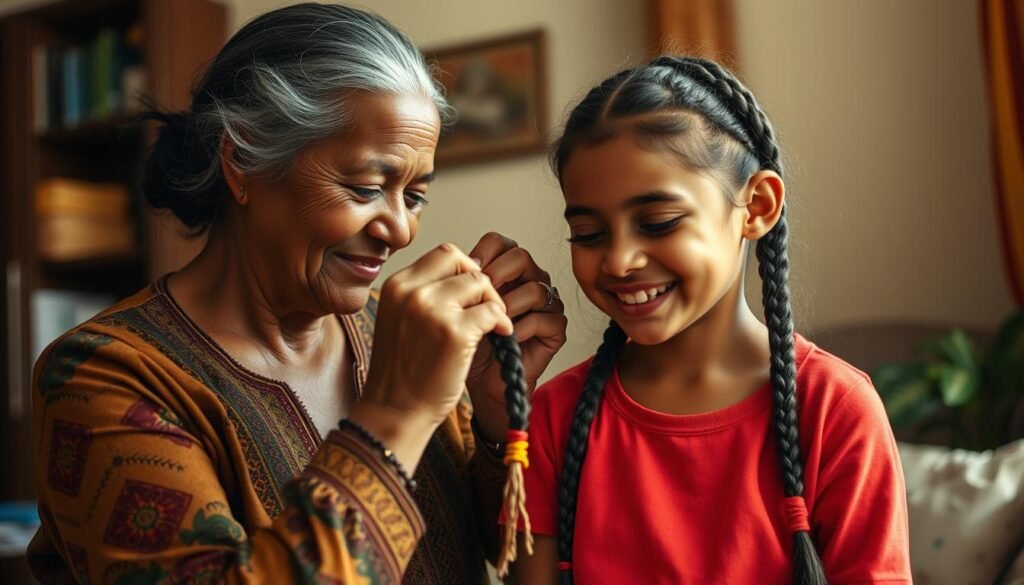
Intergenerational knowledge transmission through braiding, a practice common across many cultures
In many African and African diaspora communities, hair braiding salons serve as important social hubs where news is shared, relationships are formed, and cultural practices are maintained. The hours spent creating intricate styles provide opportunities for mentorship, with experienced braiders passing techniques to younger generations.
Similarly, in Native American communities, braiding ceremonies often bring together multiple generations, creating spaces for elders to share tribal histories, spiritual teachings, and cultural values while working with younger people’s hair.
This communal dimension of braiding highlights how hairstyling practices can serve as vehicles for cultural preservation and community building, extending far beyond aesthetic considerations.
Key Takeaways: The Enduring Significance of Braiding
Key Takeaway: Braiding is not merely a hairstyling technique but a rich cultural practice with deep historical roots that has served as a form of communication, identity expression, and community building across diverse societies throughout human history.
As we’ve explored in this journey through the cultural history of braiding, these woven hairstyles have consistently served multiple purposes:
- Cultural Identity: Braids have helped people express belonging to specific cultural groups and traditions
- Social Communication: Braiding styles have communicated important information about age, marital status, social position, and wealth
- Spiritual Practice: Many cultures have incorporated braiding into religious and spiritual rituals
- Practical Protection: Braids have protected hair from environmental damage while requiring minimal daily maintenance
- Political Expression: Braided styles have served as powerful symbols of resistance and cultural pride
- Community Building: The practice of braiding has created spaces for intergenerational knowledge sharing and social bonding
Understanding this rich cultural history allows us to appreciate braided hairstyles not just for their beauty but for their profound social significance and the generations of knowledge they represent.
Conclusion: Honoring the Cultural Legacy of Braiding
The art of braiding represents one of humanity’s oldest and most widespread cultural practices—a testament to our shared creativity and the universal human desire to transform the body into a canvas for expression. From the ancient cornrows of Africa to the elaborate plaits of Viking warriors, braided hairstyles have woven together practical needs, aesthetic preferences, spiritual beliefs, and social communications into intricate patterns that continue to evolve today.
As we’ve seen throughout this exploration, braids are never “just hair.” They carry histories, identities, resistances, and celebrations within their woven strands. By learning about the diverse cultural traditions of braiding, we gain not only appreciation for beautiful hairstyles but deeper understanding of human societies and the many ways we communicate who we are through bodily practices.
Whether you wear braids as a connection to your cultural heritage, as a practical style choice, or as an aesthetic preference, understanding their rich history can deepen your appreciation for this enduring art form that has truly stood the test of time.
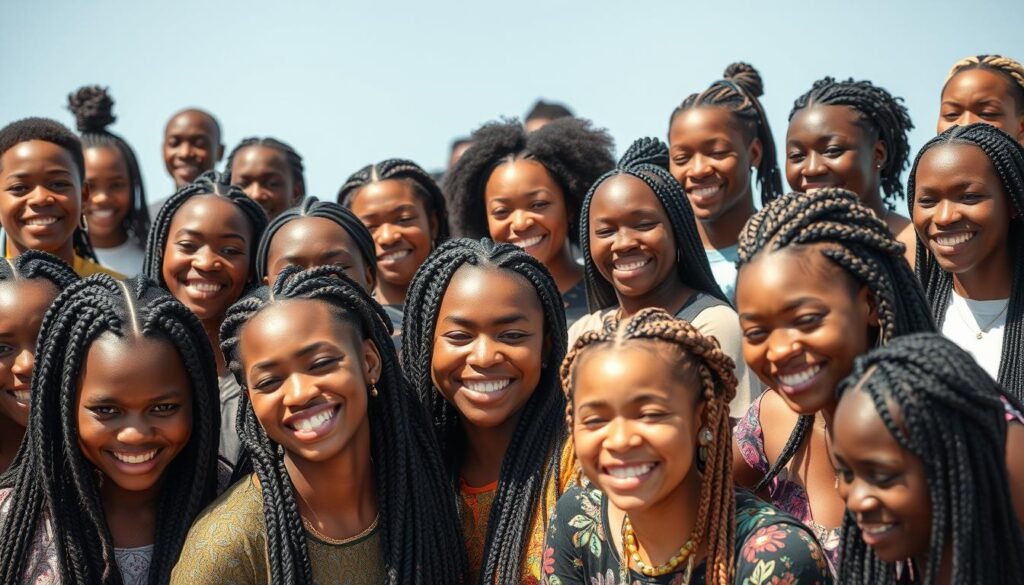
The global legacy of braiding continues to evolve while honoring its diverse cultural roots
Deepen Your Understanding of Cultural Braiding Traditions
Want to learn more about the rich cultural history of braiding techniques from around the world? Our comprehensive illustrated guide explores traditional patterns, their cultural significance, and step-by-step instructions for creating authentic styles with respect for their origins.




Braids as Social Language: Status, Spirituality, and Identity
Throughout history, braided hairstyles have functioned as a sophisticated form of non-verbal communication, conveying information about the wearer’s place in society, spiritual beliefs, and personal identity.
Markers of Social Status and Wealth
In many cultures, the complexity, size, and adornments of braids indicated a person’s social standing and wealth. More elaborate styles often signified higher status, as they required more time, skill, and resources to create and maintain.
In ancient Egypt, wealthy individuals adorned their braids with gold threads, beads, and precious stones. The time required to create such styles also indicated that the wearer had leisure time—a luxury not afforded to those of lower social classes.
Similarly, in various African cultures, the intricacy of braiding patterns and the quality of adornments—such as cowrie shells, amber, coral, or silver—indicated a family’s prosperity and standing within the community.
Spiritual and Religious Significance
Braids have held spiritual significance in many traditions, often connected to beliefs about the power of hair as a conduit for spiritual energy. In some African spiritual traditions, hair was considered a point of contact with the divine, with specific braiding rituals performed by spiritual leaders.
Spiritual ceremony involving hair braiding, demonstrating the sacred significance of the practice
In Hindu traditions, braided hair (often oiled and adorned with flowers) has been associated with religious devotion, particularly among women. The act of braiding could be accompanied by prayers or mantras, transforming a daily grooming practice into a spiritual ritual.
Markers of Age and Life Stages
Across many cultures, changes in braiding styles marked important life transitions. Children, adolescents, adults, and elders often wore distinctive styles that visually communicated their stage of life to the broader community.
Among the Himba people, young girls wear two braids, while after puberty, they transition to multiple braided strands that cover the face (called ozondato). Upon marriage, women adopt the erembe style—a braided headdress made of animal skin that symbolizes their new status.
Similarly, in traditional Hopi culture, unmarried girls wore their hair in a distinctive “squash blossom” or “butterfly” whorl style, while married women adopted a different style with two braids.